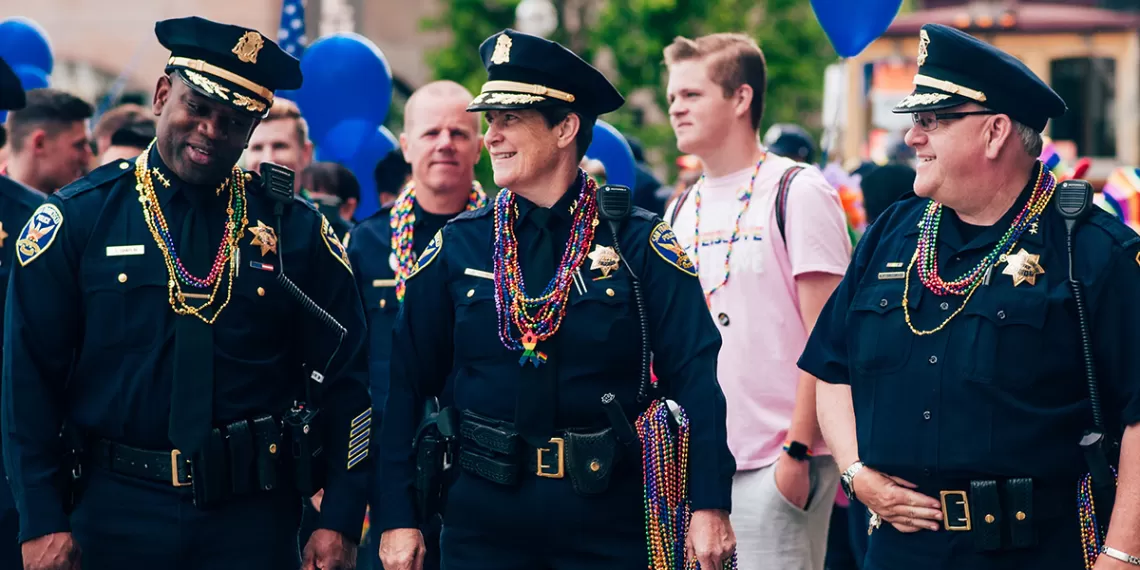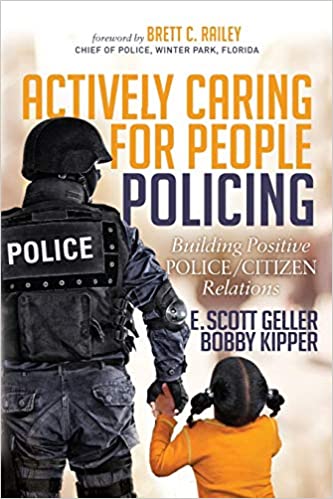
Actively Caring for People Policing
Building Positive Police/Citizen Relations by E. Scott Geller & Bobby Kipper
Guest Blogger: Megan Diamond
 Given the international spotlight on hostile confrontations between police officers and citizens, is it possible to imagine a police officer as a community servant helping to prevent crime with positive consequences? Dr. Scott Geller, the founder of the Actively Caring for People (AC4P) Movement and a distinguished University Professor at Virginia Tech, envisions a future where proactive-positive community policing takes precedence over reactive-punitive policing. Bobby Kipper, a decorated former police officer and the founder and director of the National Center for Prevention of Community Violence, shares the same perspective. In their book, Actively Caring for People Policing, Geller and Kipper provide an education/training manual for police officers that connects research-based principles of applied behavioral science (ABS) with community policing.
Given the international spotlight on hostile confrontations between police officers and citizens, is it possible to imagine a police officer as a community servant helping to prevent crime with positive consequences? Dr. Scott Geller, the founder of the Actively Caring for People (AC4P) Movement and a distinguished University Professor at Virginia Tech, envisions a future where proactive-positive community policing takes precedence over reactive-punitive policing. Bobby Kipper, a decorated former police officer and the founder and director of the National Center for Prevention of Community Violence, shares the same perspective. In their book, Actively Caring for People Policing, Geller and Kipper provide an education/training manual for police officers that connects research-based principles of applied behavioral science (ABS) with community policing.
Their purpose: To create a citizen-centered policing framework aimed at promoting positive police-citizen relations.
AC4P policing involves shifting the punitive approach to reduce the frequency of illegal behavior to the use of positive consequences to increase the quantity and improve the quality of desirable behavior. This teaching/learning process embraces seven research-based lessons from psychological science relevant for preventing interpersonal conflict, violence, and harm throughout a community. The first step is to educate officers on the benefits of using more positive than negative consequences to improve behavior, followed by thorough training on how to deliver positive consequences in ways that help cultivate interpersonal trust. This innovative and inspirational manual provides a vision of police officers becoming AC4P agents of cultivating a culture of interdependent compassion—a dramatic shift from our customary "click it or ticket" culture.
Lesson 1: Employ More Positive Consequences
Typically, people use negative consequences to control behavior due to their convenient and immediate impact. However, this approach lacks a long-term effect and stifles positive interpersonal relations. This chapter defines the most effective and efficient way to improve others' behavior and attitude by employing positive consequences. At the end of the chapter, the authors provide discussion questions that inspire police officers to brainstorm productive ways for them to deliver positive consequences for prosocial behavior.
Lesson 2: Benefit from Observational Learning
This chapter highlights the public's negative perception of police interactions due to the lack of positive police-citizen encounters reported by the media. Although most police-citizen interactions are actually positive, the reporting of the recent deaths of Breanna Taylor and George Floyd exemplify how a negative public perception can overshadow the many positive interactions between police officers and citizens. Of course, these are tragic incidents and should not go unresolved, but this is precisely why this training manual is so necessary for agents of positive change. At the end of this chapter, discussion questions challenge police officers to describe their positive behavioral observations before and after becoming an officer. For example, one question challenges officers to remember their prior observations of police officers and determine if this ultimately inspired them to become law-enforcement officials. In contrast, the next question asks about particular policing behaviors they have learned from watching other officers on duty.
Lesson 3: Improve with Behavioral Feedforward and Feedback
In order to optimize their performance, police officers need to give each other supportive and corrective feedback. This chapter describes AC4P coaching with the acronym COACH, representing Care, Observe, Analyze, Communicate, and Help. The authors detail strategies for delivering feedback most effectively and for accepting and appreciating feedback from others. The discussion questions are particularly significant because they request honesty in reporting past-situations regarding the delivery and reception of behavior-based feedback and describing interactions with the community that they could have handled better with the proper application of behavioral feedback.
Lesson 4: Use More Supportive Than Corrective Feedback
This chapter details how to deliver supportive feedback most effectively and accept it from others. This part of the training includes a role-playing exercise to practice the specific steps necessary to accomplish proper feedback delivery and reception. Charts are provided for an officer to document specific interpersonal feedforward and feedback experiences, even after completing the training.
Lesson 5: Embrace and Practice Empathy
A common disconnect between police officers and the community is the lack of empathic awareness and appreciation for police-citizen interactions. It is not easy to maintain an empathic mindset during all interpersonal encounters, but one way to start is through AC4P empathic listening. The authors provide humanistic guidelines for engaging in one-on-one empathic listening, which is more important than ever in our technology-driven world. This lesson ends with a training exercise aimed at providing participants effective practice to experience the beneficial impact of empathic listening.
Lesson 6: Distinguish Between Managing Behavior and Leading People
This chapter defines the difference between a manager and a leader and reveals how both roles differentially affect people. One particularly useful takeaway for me was the difference between self-motivation and empowerment and ways to enhance both in ourselves and among others. People need to feel empowered to work for goal achievement, including avoiding aversive consequences and acquiring desirable consequences. The discussion questions activate interactive engagement whereby participants express their viewpoints and verbalize connections between principles of self-motivation and their own life experiences.
Lesson 7: Progress from Self-Actualization to Self-Transcendence
This lesson describes Maslow's revised hierarchy of needs, which places self-transcendence at the top. This concept calls on individuals to go beyond self-interest and actively care for others—perform AC4P behavior. The final discussion questions ask readers to brainstorm effective ways to self-transcend in the community as a police officer. The main takeaway: Every time police officers distribute an AC4P wristband to a community member, they become more committed to the AC4P mission of building positive police-citizen relations and cultivating a culture of interpersonal compassion.
For me, a special contribution of this scholarship is the depth of information provided on humanistic behaviorism and other psychological principles translated into evidence-based directives anyone can comprehend, appreciate, and practice. The foundation of AC4P principles rests on empirical research, and at the end of their manual, the authors report positive AC4P results from participating police departments. There has never been a more critical time for police officers to read this publication and apply the practical AC4P principles in their police departments nationwide.
The authors summarize the education/training that officers undergo before receiving their badge, including strategic use of force, defensive tactics, and interrogation procedures. However, police officers also need to learn and practice positive, proactive approaches to community policing and thereby contribute to cultivating a community of trust and compassion between law enforcement officers and the citizens they serve. This teaching/learning manual shows you how to make that happen.
